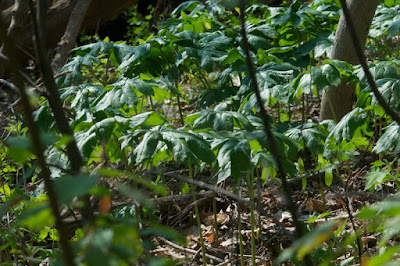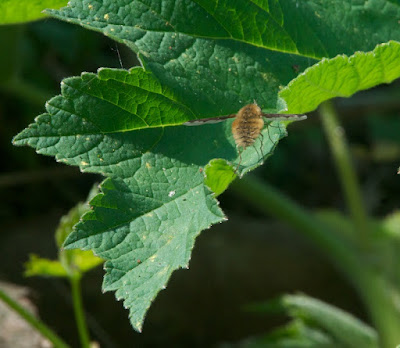From a naturalist’s point of view, that meant occasional walks with Grandpa through the nearby Erindale Park, where we could watch the coming of spring in the woods lining the Credit River.
This early in the season, most of the spring migrant birds have yet to arrive. Black-capped Chickadees (Poecile atricapilla) have the woods more or less to themselves and allow close approach...
The flowers of Mayapple or American Mandrake (Podophyllum peltatum), by contrast, are inconspicuous, hanging, often out of sight, below its large, incised leaves. It’s alternative name is a clue to its nature: the whole plant is highly toxic, though the fully mature fruit can be eaten in small quantities and native Americans once boiled the roots as a cure for stomach ache. Mayapples always appear in clusters, which are actually colonies joined by a single root system.
On April 19 spring was only beginning along the Credit. Dried stalks of last summer’s growth included Common Burdock (Arctium minus), still dominating the edges of the riverside path, and Ryan had to learn to avoid its hooked burrs.
The petals of Bloodroot (Sanguinaria canadensis), named for its bright red roots, were only beginning to unfold.
The mottled leaves of Yellow Trout-Lily or Dogtooth Violet (Erythronium americium) poked through last year’s litter, as yet unaccompanied by their flowers.
The most conspicuous flowers, indeed, were not native: large drifts of an early-blooming garden escapee, Siberian Squill (Scilla siberica).
In North America, some of the earliest native bloomers are among the least conspicuous. Wind-pollinated deciduous trees like this Boxelder (Acer negundo), a small species of maple, do not need to attract birds or insects, but they do need to release their pollen before their emerging leaves grow big enough to block the flow of air around their flowers. Unusually for a maple, male and female boxelder flowers are borne on separate trees. This one is a male, it’s pollen-laden anthers only beginning to emerge.
When fully mature, as you can see in this photo taken on May 3, the anthers dangle on long filaments, freely exposed to the winds that will carry their pollen to the waiting female trees.
This early in the season, most of the spring migrant birds have yet to arrive. Black-capped Chickadees (Poecile atricapilla) have the woods more or less to themselves and allow close approach...
...particularly at feeding trays scattered along the path.
By May 9 leaf growth was already well advanced, and flowers carpeted the ground beneath the trees.
Ontario’s official flower, the White Trillium (Trillium grandiflorum), spread its three-petaled blooms in the deeper shade. I explained to Ryan that you are not allowed to pick trilliums, because the whirl of leaves just below the flower are the only ones it will develop and picking below the leaves milks the plant. I remember being taught the same thing by my schoolteachers almost sixty years earlier.
By May 9 leaf growth was already well advanced, and flowers carpeted the ground beneath the trees.
Ontario’s official flower, the White Trillium (Trillium grandiflorum), spread its three-petaled blooms in the deeper shade. I explained to Ryan that you are not allowed to pick trilliums, because the whirl of leaves just below the flower are the only ones it will develop and picking below the leaves milks the plant. I remember being taught the same thing by my schoolteachers almost sixty years earlier.
The flowers of Mayapple or American Mandrake (Podophyllum peltatum), by contrast, are inconspicuous, hanging, often out of sight, below its large, incised leaves. It’s alternative name is a clue to its nature: the whole plant is highly toxic, though the fully mature fruit can be eaten in small quantities and native Americans once boiled the roots as a cure for stomach ache. Mayapples always appear in clusters, which are actually colonies joined by a single root system.
Like the Mayapple, the White Trout Lily (Erythronium albidum) allows its flowers to droop, but because the leaves are narrower and arise only at ground level the flowers, when they appear, remain easy to see.
The Spotted Cranesbill (Geranium maculatum), a widespread native, takes its name from its fruit. The fruit sports a long column that does give the whole thing the appearance of the head of a long-beaked bird. Note that cranesbills are the ‘true’ geraniums; the plants sold as geraniums in North America actually belong to a related genus, Pelargonium, from South Africa. In Europe and other areas these plants are in fact sold as pelargoniums, or simply pelargs.
Violets can be tricky to identify, but I believe that this is the Common Blue Violet (Viola papilionacea).
This is another batch of wind-pollinated maple flowers - this time from an invasive European exotic, the Norway Maple (Acer platanoides).
This is another batch of wind-pollinated maple flowers - this time from an invasive European exotic, the Norway Maple (Acer platanoides).
It can still be quite cool in Ontario in early May, and many insects have yet to emerge. This is a Large or Greater Bee Fly (Bombylius major), a spring-flying, nectar-feeding bee mimic widespread across much of the temperate Northern Hemisphere.
Red Admirals (Vanessa atalanta) are among the earliest of spring butterflies. The first adults to emerge from winter dormancy are, in fact, are too early for many nectar-bearing flowers, and this early in the season they get much of the sugar they need from the sap of bushes or trees.
The Six-spotted Tiger Beetle (Cicindela sexguttata) is common in Ontario, but it looks exotic enough to have wandered out of a Malaysian rainforest. Tiger beetles, as their name suggests, are active hunters, preying on insects and other small arthropods on the forest floor.
For some reason the Credit Valley gets fewer passage bird migrants than other places in Mississauga (despite its handsome-looking woodlands), but we found that that the local Spotted Sandpipers (Actitis macularia) had already returned.
This is one of the few migrating sandpipers that stay to breed in our area, rather than heading northwards towards the boreal forest or the tundra. Like its Old World cousin the Common Sandpiper (Actitis hypoleuca) this is a relentless ‘teeterer’, constantly bobbing up and down as it walks - we aren’t really sure why.
Eastern Grey Squirrels (Sciurus carolinensis) have been active here all winter. In our area, many, like this one, are black instead of grey, but these are simply colour forms of the same species. Occasionally you can even find a white one.
Once things get going in Ontario, spring can advance at a roar. Two days later, on 11 May, there were still more flowers about, the local Song Sparrows (Melospiza melodia) were singing their jangling songs...
For some reason the Credit Valley gets fewer passage bird migrants than other places in Mississauga (despite its handsome-looking woodlands), but we found that that the local Spotted Sandpipers (Actitis macularia) had already returned.
This is one of the few migrating sandpipers that stay to breed in our area, rather than heading northwards towards the boreal forest or the tundra. Like its Old World cousin the Common Sandpiper (Actitis hypoleuca) this is a relentless ‘teeterer’, constantly bobbing up and down as it walks - we aren’t really sure why.
Eastern Grey Squirrels (Sciurus carolinensis) have been active here all winter. In our area, many, like this one, are black instead of grey, but these are simply colour forms of the same species. Occasionally you can even find a white one.
Once things get going in Ontario, spring can advance at a roar. Two days later, on 11 May, there were still more flowers about, the local Song Sparrows (Melospiza melodia) were singing their jangling songs...
... and the very different whistles of White-throated Sparrows (Zonotrichia albicollis), birds passing through to their breeding grounds farther north, could be heard from the woodlands. In the United States the song of the White-throated Sparrow is traditionally rendered as “Old Joe Peabody, Peabody, Peabody”, but we Canadians know that the bird is actually saying “Dear sweet Canada, Canada, Canada”!
For some birds at least, the breeding season was already under way. Male Red-winged Blackbirds (Agelaius phoeniceus) had arrived some time before, challenging rivals over the choicest territories. The difference among territories would determine their mating success. Females, who arrive later than males, select their mates not on the basis of male plumage and display but on their success at acquiring the best piece of real estate. By now, though, the females had returned and made their choices. Ryan and I found this female, obviously already settled in, gathering material for her nest.
For some birds at least, the breeding season was already under way. Male Red-winged Blackbirds (Agelaius phoeniceus) had arrived some time before, challenging rivals over the choicest territories. The difference among territories would determine their mating success. Females, who arrive later than males, select their mates not on the basis of male plumage and display but on their success at acquiring the best piece of real estate. By now, though, the females had returned and made their choices. Ryan and I found this female, obviously already settled in, gathering material for her nest.
By now, trees that depended on insect pollinators could safely put out their flowers. The blooms of Canadian Serviceberry (Amelanchier canadensis) are attractive enough to make it a garden favourite; we even have one in our front yard, where its sprays of white blossoms are a sure sign that the last shreds of winter have departed.
Spring, in short, was here in full force. Trilliums were at their peak; in a few weeks their flowers would be gone.
The leaves of Mayapple had already spread to their full extent, concealing the inconspicuous flowers below.
More woodland plants were now in flower, displaying colours from the delicate pastels of the Wood Anemone (Anemone nemorosa)...
...to the shiny, almost coarse buttercup-yellow petals of the Marsh Marigold Caltha palustris), which despite its English name actually is a sort of buttercup.
Eastern Chipmunks (Tamias striatus) busily explored the forest floor...
...checking out the growing seedings for whatever they could find...
...while a gang of male Mallards (Anas platyrhynchos) swam placidly along the banks of the river. As for Ryan, he had witnessed something he could never have seen at home in Malaysia, despite its biological richness: the change of the seasons, and the coming of spring.
Eastern Chipmunks (Tamias striatus) busily explored the forest floor...
...checking out the growing seedings for whatever they could find...
...while a gang of male Mallards (Anas platyrhynchos) swam placidly along the banks of the river. As for Ryan, he had witnessed something he could never have seen at home in Malaysia, despite its biological richness: the change of the seasons, and the coming of spring.


















































No comments:
Post a Comment